Have you heard about the route of medieval churches? It is a tourist attraction incorporating medieval churches in northeastern Hungary, the Sub-Carpathia and the ’Partium’ into a themed route. During my first tour of the route, which covered most of the Hungarian part, I stumbled upon one wondrous church after another. It’s a sad fact that not only foreigners, but also Hungarians, are unfamiliar with these unique treasures.
The ‘star’ of the area’s medieval churches, the most well-known one, is the late Romanesque church of Csaroda. It is open to the public, so there is no need to ask around for its keys, and it visibly attracts the most visitors.
The church of the ’smiling saints’
The church was built in the second half of the 13th century. Its unique frescos originate from the same era, although two centuries later, during the Reformation, Calvinists found them inappropriate and covered them. Much to our relief, they did not eliminate the paintings altogether as they usually did at that time, instead, the walls were whitewashed. Later in 1642, floral and leafy patterns were added. The new patterns could have been valuable too, if the more exciting, supremely beautiful frescos had not been uncovered from beneath.
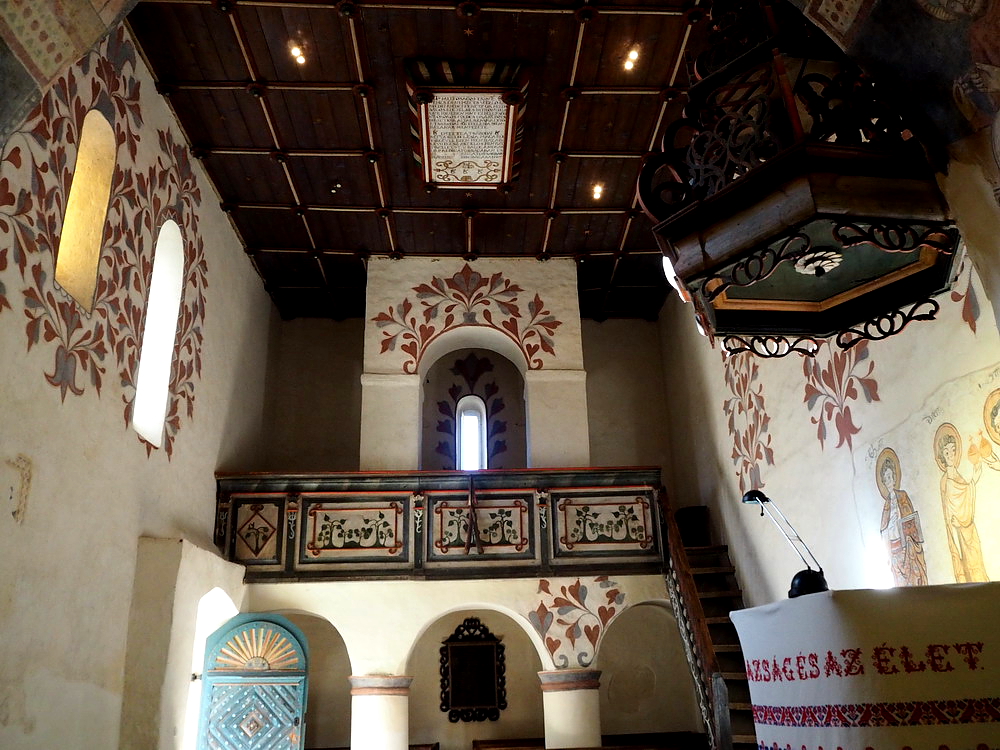
The apostles, Virgin Mary, the little Jesus, the resurrected Christ and all the other figures on the original frescos are smiling; that’s why Csaroda’s church are also referred to as the church of ‘smiling saints’. The tender figures with their rosy cheeks add a peaceful and charming atmosphere to the church.
The pulpit and the choir are covered with the so called ‘Csaroda’ homespun; while the wooden craftwork, that is the pulpit, the coffered ceiling, the choir and the benches originate from the 18th century. The key construction documents of the church are kept safe in a box attached to the ceiling to save them from damage in case of a potential flood. The leafy patterns appear on the exterior façade too. The lady who thoughtfully showed me around added that the images were inspired by the embroidery patterns typical of the area.
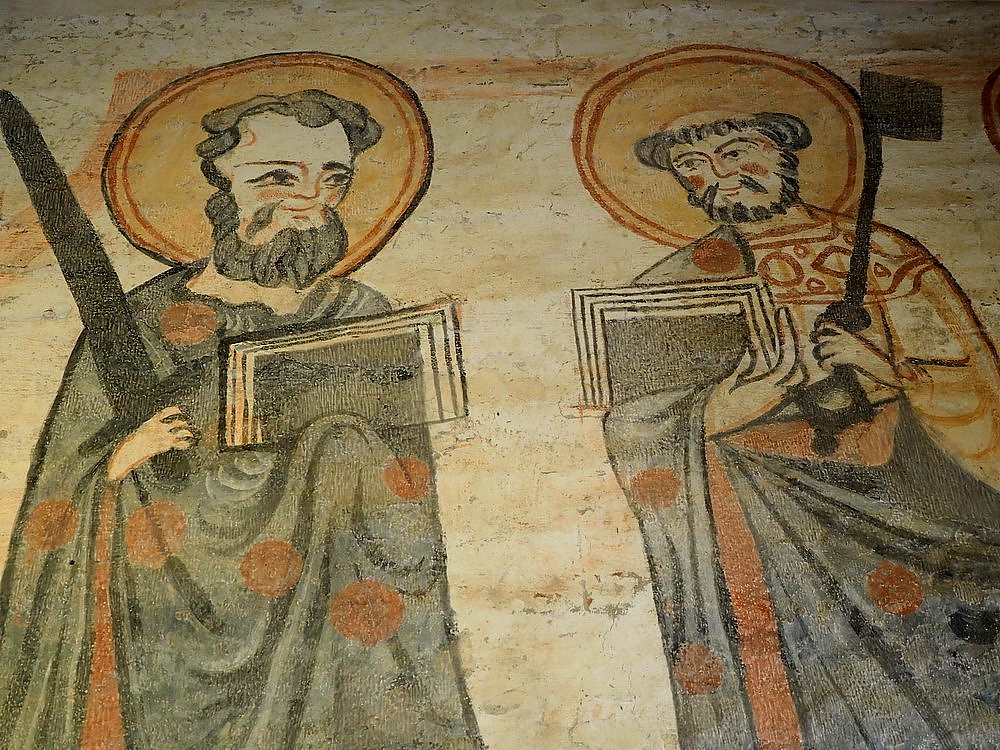
In the churches of the ’Szatmár’ area, ceilings are typically either covered by patterns or painted blue. Consequently, I was surprised that here, it was painted brown. Later on, I found out that this church is not an exception, sadly the blue cover has worn off and they cannot afford a renovation. As soon as they can raise sufficient funds, the original state shall be restored.
The bare-foot Notre Dame
Whilst it is not the extraordinary size of the church in Csaroda which captivates a visitor, the one in Tákos is even tinier. In fact, it is almost hidden by a large bell tower emerging beside it. While in Csaroda, they had an extensive budget to build up the patron church from burnt bricks; the ‘peasants’ church’ in Tákos, or, as it is referred to by locals, the ‘bare-foot Notre Dame’ was made of twigs and mud, like a bird’s nest.
Its roofing is supported by lumber footing (columns), its floor is made of packed clay. Though the church was built in 1766, it looks much older: it is one of the last representatives of medieval-style, rural mud churches. This architectural method resulted in a surprisingly stable structure saving the church even from the latest flood in 2001.
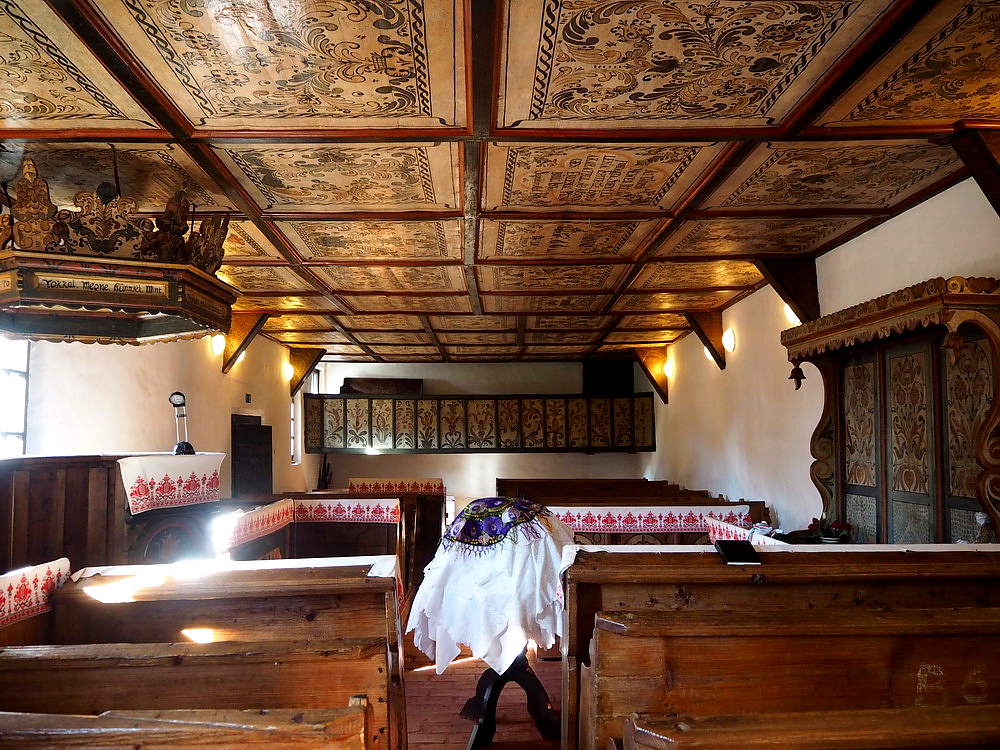
Everything inside originates from the 18th century including the 58 cassettes of the marvelously painted ceiling and the nicely decorated benches. This time there were no issues with the key as we arrived at the same time as the bell ringer, who let me straight in. The kind elderly gentleman was eager to share stories of the church. He sadly added that instead of a former congregation of 50-60 people, nowadays only 8-10 people regularly attend the service, except around Christmas time and New Year’s Eve when the small church gets crowded.
The saints of Lónya are smiling too
It was quite an adventure to get to Lónya: I had to take the ferry to cross the river Tisza. The short river cruise was quite cozy in the morning fog. The main attraction of the village is a heritage of the Reformation: a Romanian style church from the 13th century. I found a mobile number on the information board, but unfortunately the phone was switched off. I was standing perplexed and a bit helpless in front of the building without a clue of how I was going to get in.
Then a young guy appeared and informed me that his father had left to go to Ukraine to fill up his car tank and the roaming would be too expensive. At first, I did not understand why this was relevant, but then I figured the mobile number belonged to his father. The young guy then rushed home on his bike to get the keys. What a great solution! I was flabbergasted when I stepped in.
Just like in Csaroda, smiling saints are looking back at us gently from the walls, although this church is less widely known. The wall paintings also originate from the 13th century and most likely are the work of the same artist or artist factory as those in Csaroda. In fact, some art historians say that the work in Lónya became the artist’s true professional fulfillment.
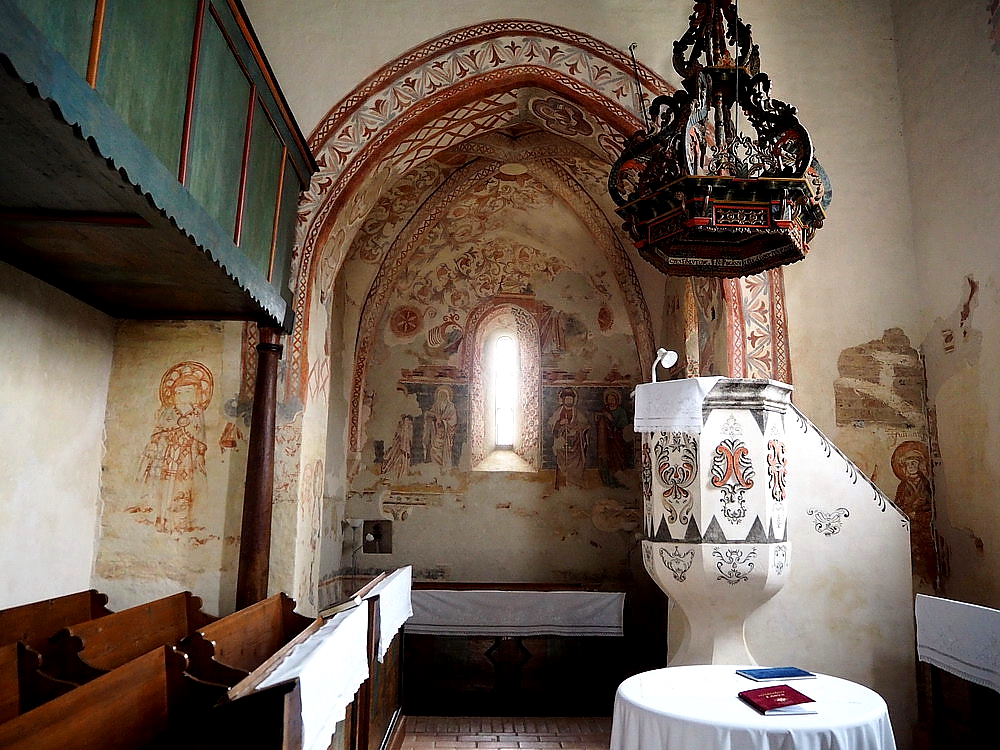
During the Reformation, the frescos here were also covered and were only discovered a few years ago, as a result of reconstruction work after the river Tisza’s flooding in 2001. The discovery is truly proof that every cloud has a silver lining. The treasures of the church include a painted wooden ceiling and a six-sided, multi-layered pulpit standing out from the rural baroque furniture. It is attributed to the same gentleman who crafted the wooden artwork of the church in Tákos – Mr. Sándor Ferenc Asztalos.
Chasing the keepers of the church keys
The church of Zsurk, just like the one in Tákos, was built after the Middle Ages, but its intricate story makes it worth mentioning.
From 1790, for approximately 100 years, a wooden church was the predecessor of the current one. It was the decision of Sámuel Almássy to replace it with a stone church, and the foundation stone was laid down in 1892. As the coffered ceiling of the wooden church was in a fairly good condition, the legend says they kept it and only pulled down the rest of the old structure beneath.
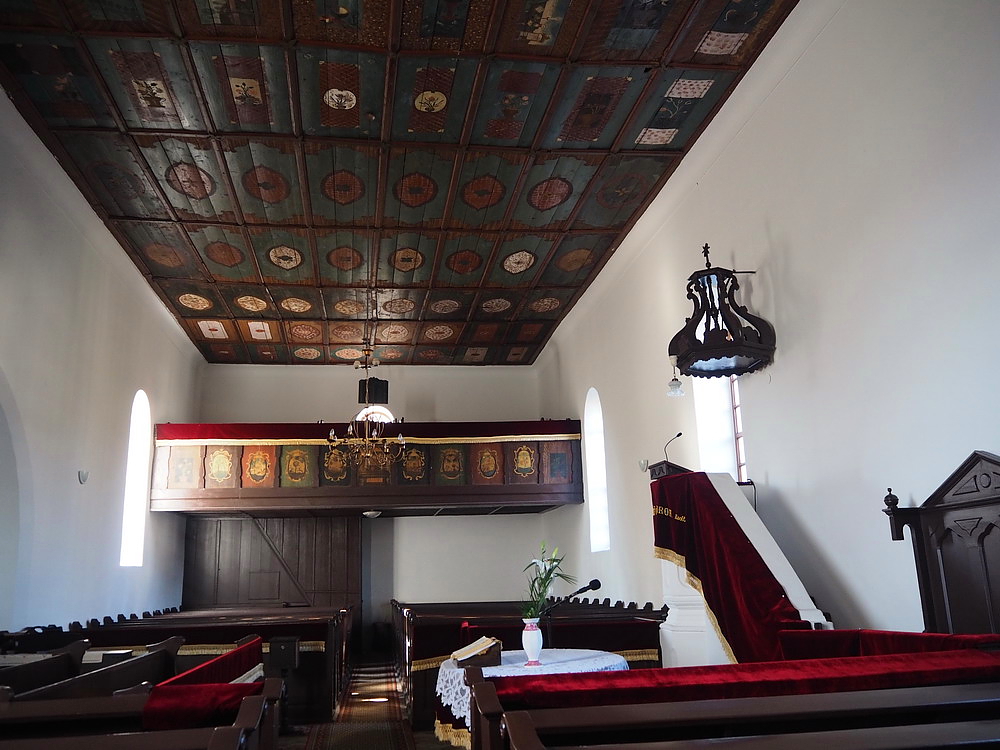
The stone church was designed for the same width as its demolished wooden predecessor, extended only to the west and with a side vessel attached to it. That’s where the only entrance can be found now. The coffers of the ceiling are decorated with allegoric representations, the pictures of flowers in vases and ornamental medallions, while the intersections of the brown beams separating the cassettes are highlighted by four-leafed, sawn roses.
As is typical of old Calvinist churches, a hundreds of years old wooden bell tower emerges at the foot of the building. The vertical beams are almost 14 meters long and as thick as 30 x 30 centimeters. These magnificent trees were chosen from centuries-old oak forests beside the river Tisza.
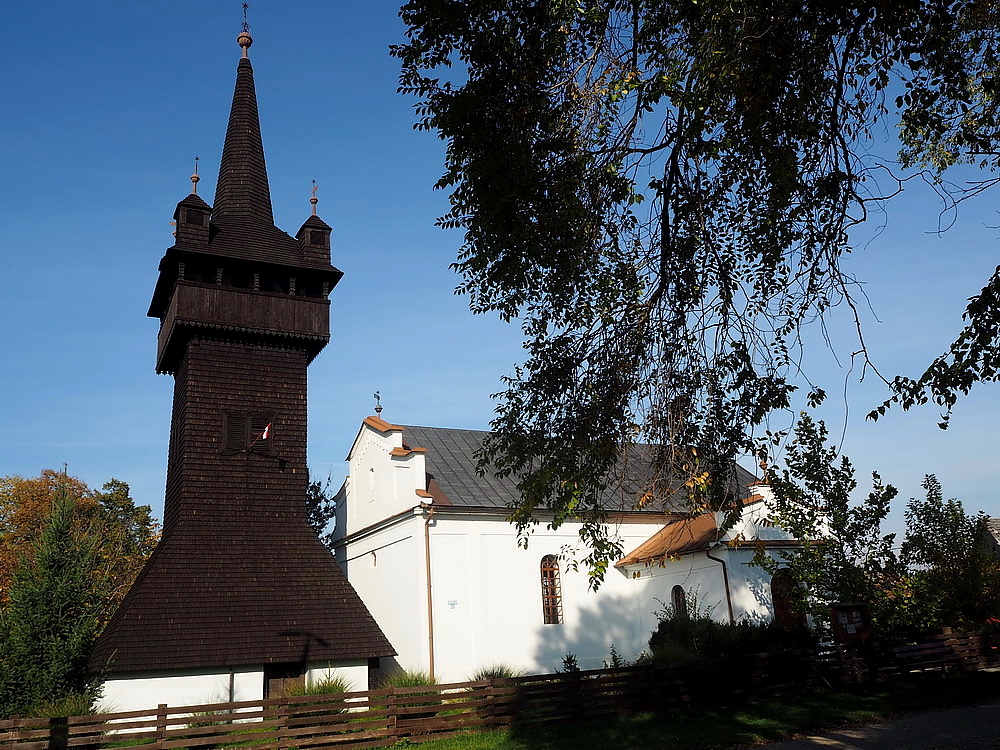
Though the village is tiny, the bell ringer, who brought the keys to let me in, says that on Sundays as many as 70-80 people get together in the church. Winter is no exception thanks to the heated benches. By the way, the keeper of the keys was once again a bit challenging to find. He did not respond to his mobile and the elderly ladies who passed by hinted that it’s pointless chasing him as he’s performing public work.
So I called the priest whose number was also shown on the information board. He turned out to be away in another village, but he promised to get hold of the bell ringer no matter how engaged he might be in his public work duties. And indeed, just as I was about to finish my sandwich, I noticed a bicycle approaching me with the keeper of the keys on it.
Late discoveries of whitewashed frescos in Nagyar
Nagyar is worth visiting not only for its castle and the so called ‘Petőfi tree’, but for the rare wall paintings and the ornate pulpit that await the visitor in its Calvinist church. The gothic style catholic chapel, originally built under the reign of King Zsigmond, has continued to be attended by the inhabitants following their conversion to Calvinism in the 16th century. The walls were whitewashed and the building was renovated several times over the centuries, and a significant reconstruction took place in the 19th century.
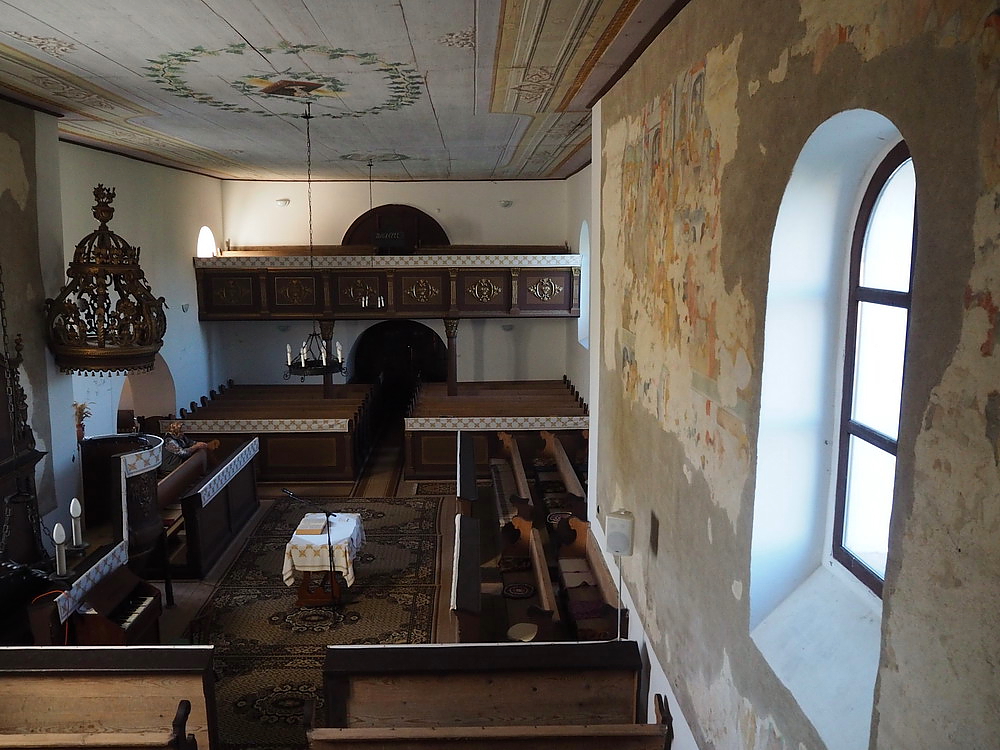
By now only small traces give away that it’s a medieval church. The sanctuary was pulled down, the inner triumphal arch and the outer retaining walls were lifted, the nave was doubled, and a tower was added.
During an uncovering of a wall in the 1990’s, exquisite Renaissance frescoes, unique in the region, were discovered. Unfortunately, the reconstruction work in the 19th century and the new windows that were added have mostly destroyed the sequence of 10 paintings depicting Jesus Christ’s crucifixion and passion. However, two of the paintings: Jesus’ triumphal entry into Jerusalem and the Last Supper, even if not perfectly recovered, are visible again.
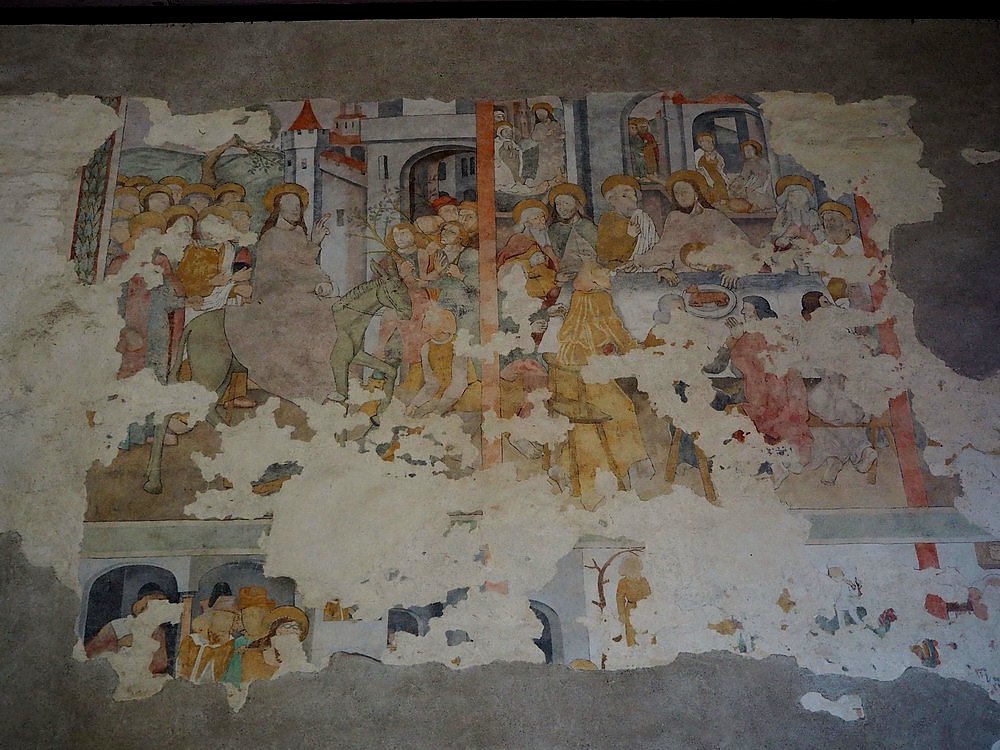
Treasures hidden on the walls in Sonkád
Upon my arrival to Sonkád, I was curious to see one of the three churches of the Upper-Tisza area that owns the ’Europa Nostra’ certification. This international award was well deserved: the building from the 15th century was rebuilt almost from ruins.
Two decades ago, close to its final demise, it was no longer suitable to celebrate masses. Sadly it seemed that it had survived the destruction of the Tartars and Turks and over 500 years of adversity, to no avail: believers had abandoned it and the owners had given up on it. Fortunately, an attempt to give it a basic renovation suddenly took a turn when the hidden treasures on the walls were discovered.
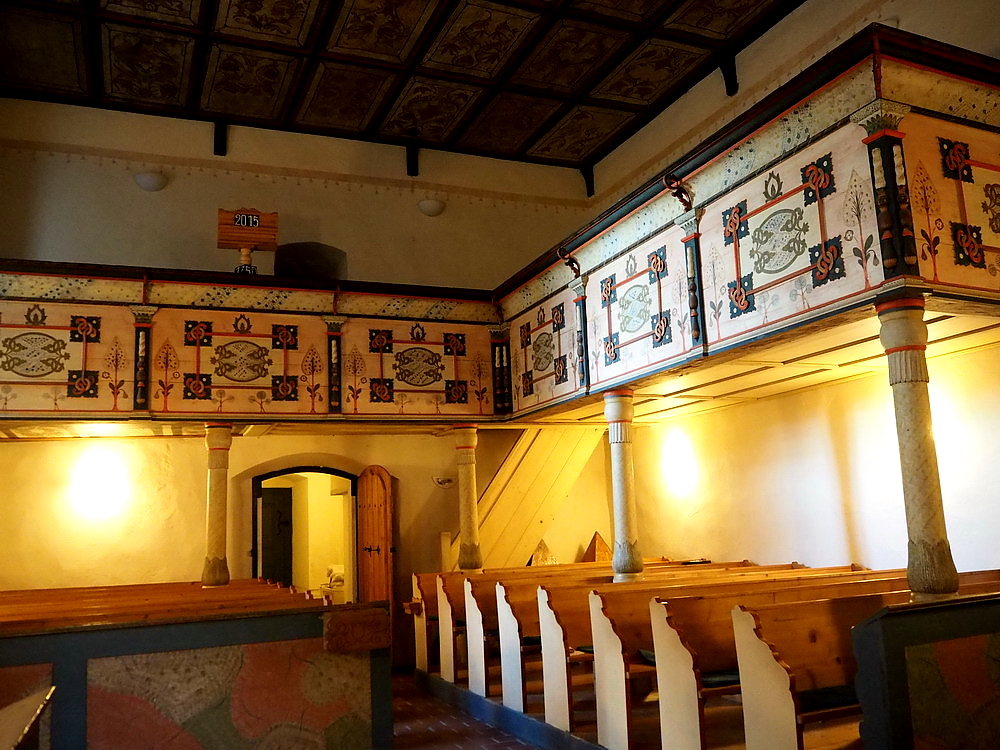
These days visitors can marvel at the detailed wooden ceiling originated from 1766 which came bubbling up from beneath the whitewashed surface. The pulpit, the gallery with its tree shaped motifs and the benches were renovated too.
Though it is a small church I took my time to marvel around as I kept discovering more and more spectacular details. Luckily, the keeper of the key didn’t hurry me, in fact, she seemed happy to see how much I appreciated the church.
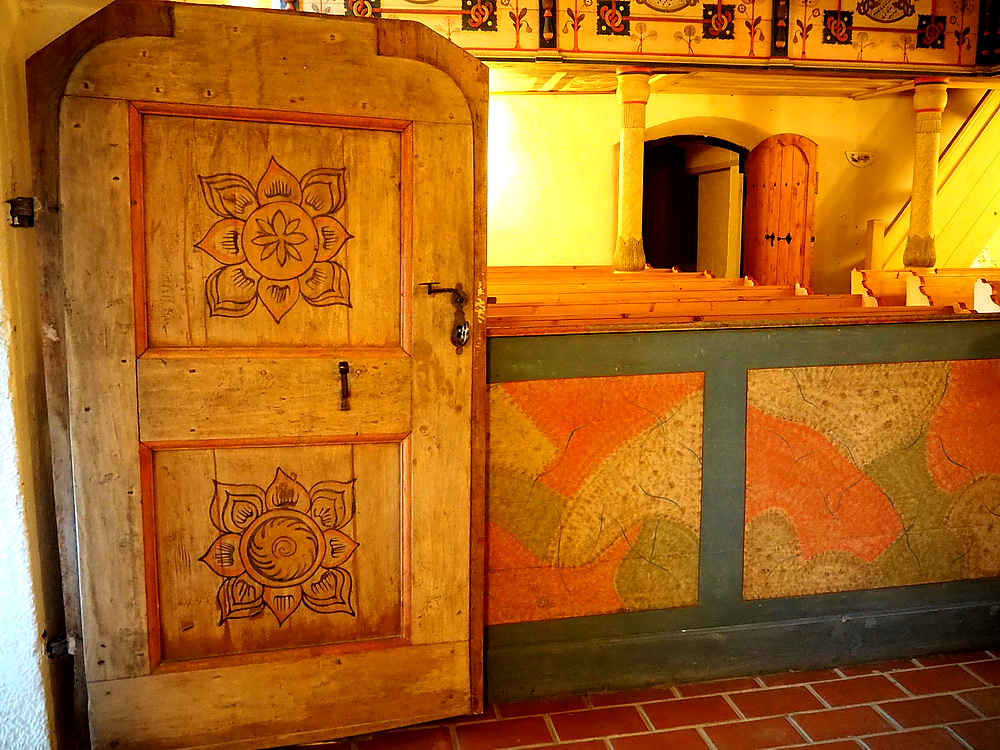
So many churches, so many interesting tales
The above churches are just a few examples from the area, but I would highly recommend visiting all the rest. The church in Túrricse welcomes you with a unique stone frame around its entrance, or Hungary’s one and only monumental, medieval stone church with its red & black brick walls and spectacular tower, which reminds you more of a castle than a church, awaits you in Csenger.
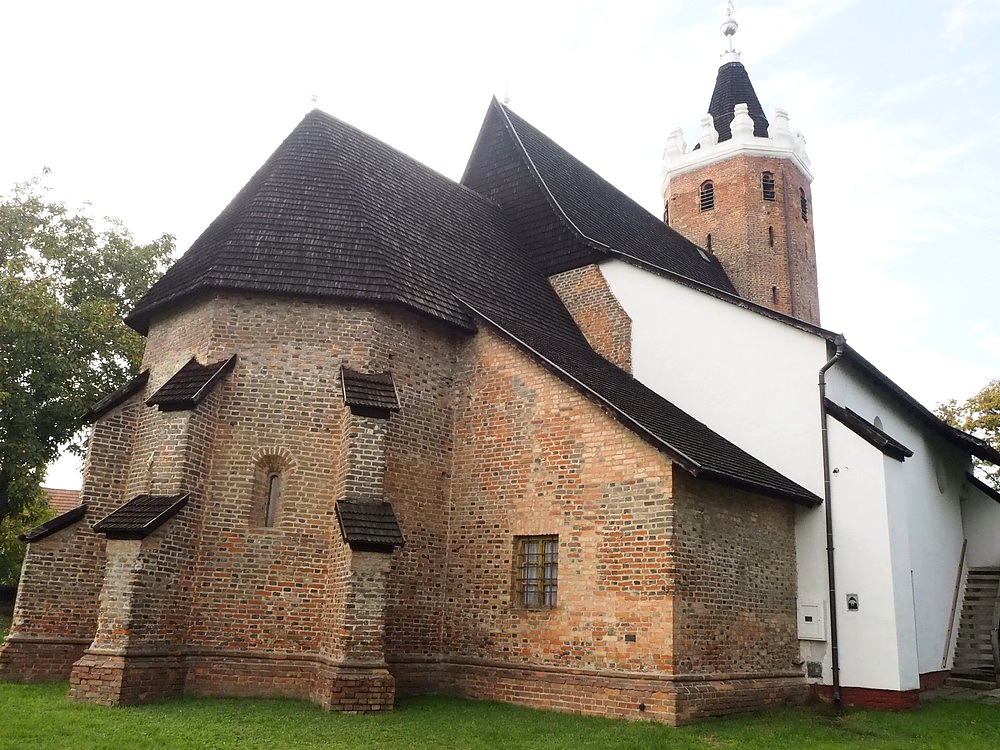
The figures and flowers decorating the cassette ceiling of Gügye’s miraculous little Calvinist church makes it the loveliest of all church ceilings throughout the Upper-Tisza (river) area. Or there’s Nagygéc, where due to a recent renovation you can still smell the fresh painting on the church walls. Another favorite of mine was the church of Vámosoroszi, which is linked to the Báthory family, the church builders of the area with the most impact. Sadly, its painted ceiling has already diminished, but the pulpit is perhaps the nicest in the region.
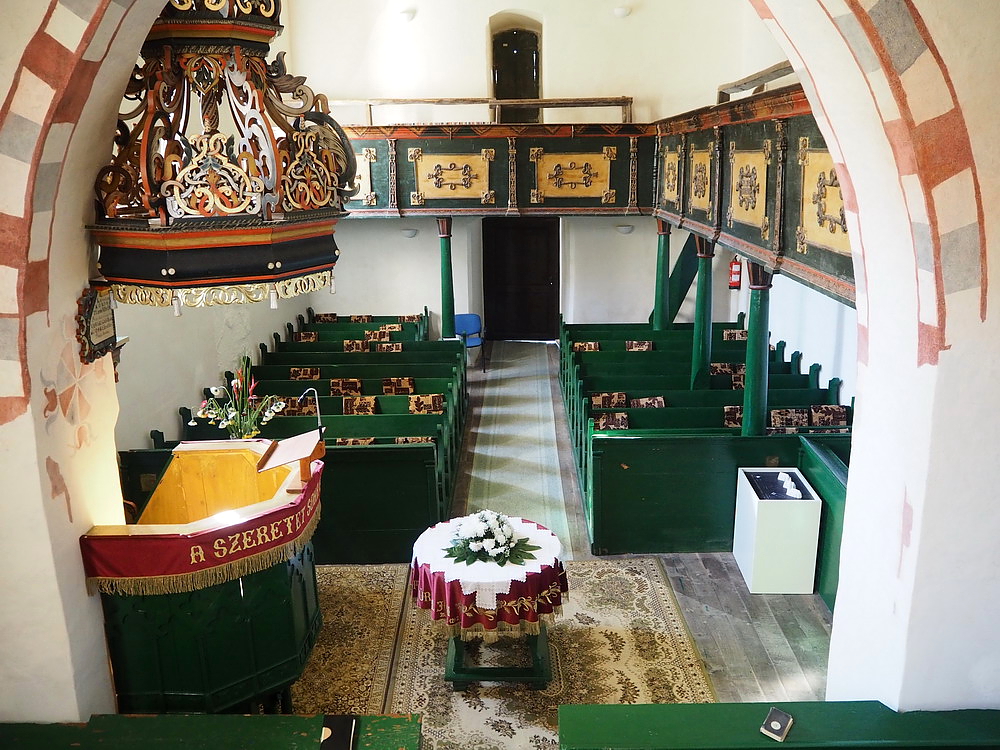
The Calvinist church of Szamosújlak from the 14th century is another to possess the Europa Nostra-commission’s award. They could just have added a banister to the staircase leading up to the gallery, as right now it’s far from being safe. There aren’t many visitors around though. The church is not attended by the congregation any more, it’s too cold inside due to the open roof. Instead, masses are celebrated in the nearby congregational hall.
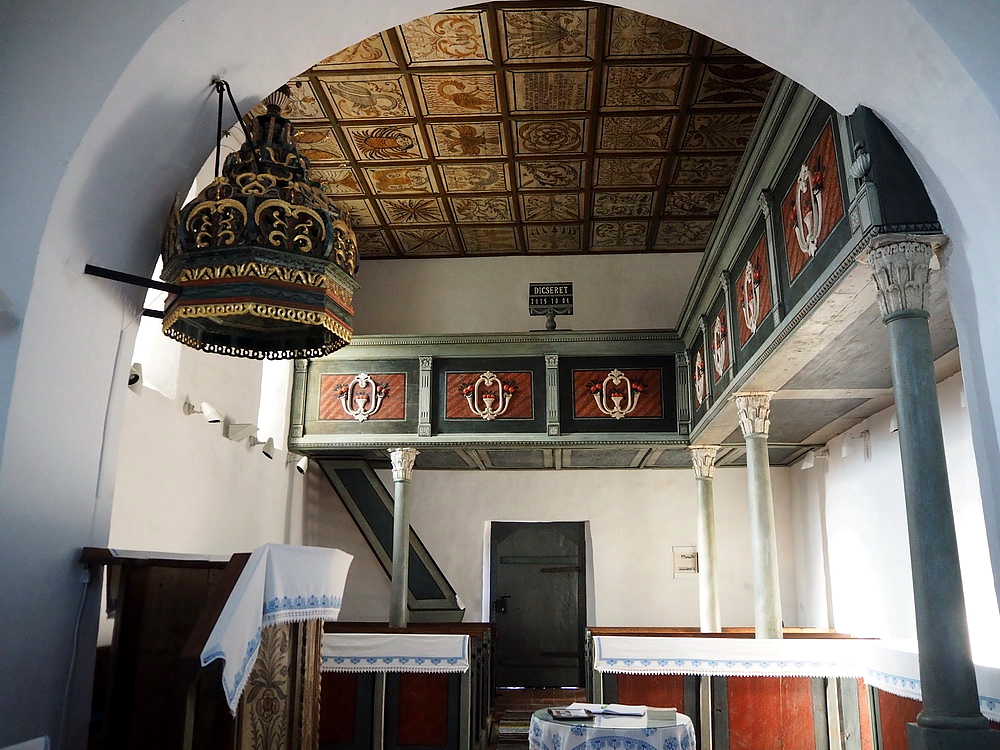
So many churches, with so many miracles and tales they tell us. In my view these churches could be considered to be part of the World Heritage site. In case you are interested in visiting them too, the internet is of great assistance. You can read up on the history of the churches beforehand, or even contact the keeper of the church key in advance to arrange an appropriate time for a visit.
